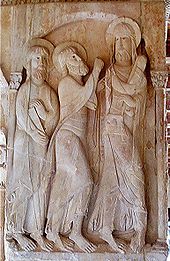Pilgrim bag
The pilgrim's bag (Latin pera ), like the pilgrim's staff, has been one of the attributes of a medieval pilgrim since the 10th century. Both were blessed ( pilgrim's blessing ) and given on the start of the journey. This distinguished them from the other parts of the pilgrim's equipment (hat and coat). Pilgrim signs like the scallop could be attached to the bag. In German, the name Wallsack for the pilgrim's bag used to be common.
The sermon Veneranda dies , ascribed to Pope Calixt II , a speech with a pilgrim's blessing, described the pilgrim's bag as a narrow, open-topped leather pouch with no straps, and interpreted these details allegorically. The provisions, especially bread, were transported in the bag.
The bag could also look different, e.g. B. the sporta (peregrinationis) was a light shoulder bag originally made of cane or similar material.
The crusades were considered armed pilgrimages. Philip II ordered that large bags be made for the journey to the Holy Land to hold the relics expected to be found there. He himself received this bag, sporta peregrinationis , from Abbot Hugo V of St. Denis, together with a pilgrim's staff and oriflame . Knights and nobles had pilgrim bags made according to the model of their king, which were decorated with their coat of arms.
The pilgrim's bag was often depicted in medieval art, not only with pilgrims to St. James , but also with (biblical) people who are characterized as travelers, for example when the risen Christ met the disciples of Emmaus ( Lk 24 : 13-34 LUT ). It is often trapezoidal, decorated with a scallop and worn on a shoulder strap, sometimes like a modern neck pouch hung around his neck.
The pilgrim or shepherd's bag is an attribute of the Apostle James the Elder and St. Wendelin .
literature
- Klaus Herbers (ed.): The Way of St. James: with a medieval pilgrim guide on the way to Santiago de Compostela. Tübingen 2001, ISBN 3-87808-312-2 .
- Leonie von Wilckens: The clothes of the pilgrims . In: Lenz Kriss-Rettenbeck , Gerda Möhler (Hrsg.): Pilgrimage knows no borders, topics related to an exhibition of the Bavarian National Museum and the Adalbert Stifter Association. Munich / Zurich 1984, pp. 174-175.
Individual evidence
- ↑ Klaus Herbers: The Way of St. James . S. 56 .
- ↑ Wallsack. In: Jacob Grimm , Wilhelm Grimm (Hrsg.): German dictionary . tape 27 : W – way [twittering] -zwiesel - (XIII). S. Hirzel, Leipzig 1922 ( woerterbuchnetz.de ).
- ↑ Klaus Herbers: The Way of St. James . S. 78-79 .
- ^ Charles du Fresne Du Cange: Glossarium Ad Scriptores Mediae & Infimae Latinitatis . tape 3 , 1710, col. 1029 .
- ↑ Alexandre Lenoir: Museum of French Monuments: Or, an Historical and Chronological Description of the Monuments, in Marble, Bronze, and Bas-relief, Collected in the Museum of Paris . Paris 1803, p. 218-219 .
- ↑ Pilgrim's costume. In: The large art dictionary by PW Hartmann. Retrieved July 26, 2018 .
- ↑ Liselotte Stauch: Bags as an attribute. In: RDK Labor. 1939, Retrieved July 26, 2018 .


